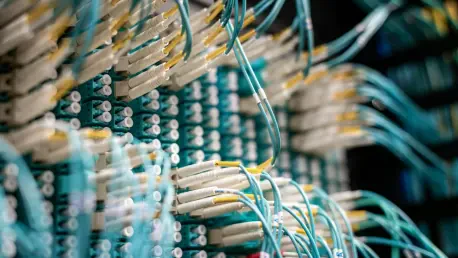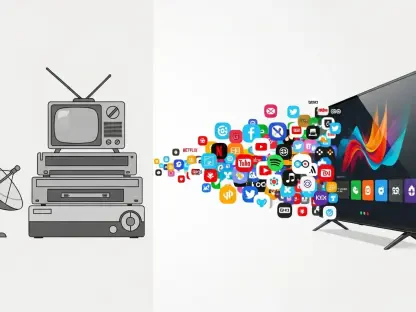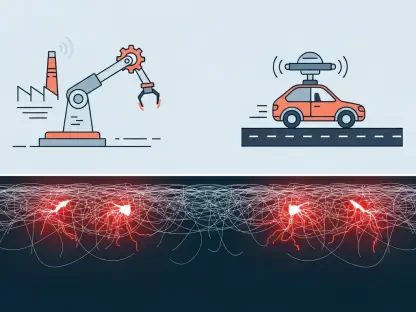In an era where digital connectivity defines economic and social progress, one city has surged ahead of global competitors to claim the title of the fastest fixed broadband hub. Lyon, a vibrant metropolis in France, has emerged as a standout leader, clocking a staggering median download speed of 347.52 Mbps according to recent global rankings. This achievement places it above powerhouses like Abu Dhabi and Valparaíso, Chile, and even outshines its national counterpart, Paris, by a significant margin. The secret behind this remarkable feat lies in an almost universal fiber optic rollout, transforming Lyon into a benchmark for high-speed internet infrastructure. As the world becomes increasingly reliant on seamless connectivity for everything from remote work to streaming, Lyon’s success offers a compelling case study in how strategic investment in technology can redefine a city’s digital landscape and set a precedent for others to follow.
Fiber Optic Dominance in Urban Connectivity
Lyon’s ascent to the top of global fixed broadband rankings is no accident but the result of meticulous planning and infrastructure development. With approximately 97% of addresses equipped for fiber connectivity, as evidenced by detailed mapping tools from France’s regulatory authority, the city has achieved near-universal access to high-speed internet. This extensive coverage translates directly into blazing-fast median speeds that leave many international cities trailing behind. The impact is profound, enabling residents and businesses to engage in data-intensive activities with ease, from ultra-high-definition streaming to real-time cloud computing. Such connectivity isn’t just a convenience; it’s a competitive edge in a digitized global economy where speed often equates to opportunity.
Moreover, Lyon’s fiber-first approach contrasts sharply with other urban centers facing logistical hurdles. While many cities grapple with outdated infrastructure or challenging urban layouts, Lyon has prioritized modern solutions, ensuring that fiber optic cables reach nearly every corner. This comprehensive rollout is supported by national initiatives aimed at elevating broadband standards across France, with ambitious targets to ensure all premises exceed 100 Mbps soon. The result is a city that not only meets current demands but is also future-proofed for emerging technologies requiring even greater bandwidth. Lyon’s model demonstrates how targeted investment can overcome common barriers to connectivity.
National Strength and Urban Contrasts
France as a whole has much to celebrate, securing a third-place ranking globally for fixed broadband speeds with a median of 319.43 Mbps, just behind leaders like Singapore and Hong Kong. This impressive standing reflects a concerted national effort through programs designed to push connectivity to world-class levels. Lyon’s performance is a shining example within this broader success, showcasing how regional implementation can amplify national goals. However, disparities exist within the country, most notably between Lyon and Paris. Despite Paris being a tech hub with a global reputation, its median speed of 238.51 Mbps places it significantly lower on the rankings, highlighting how urban density and historical architecture can complicate infrastructure upgrades.
The challenges in Paris stem from its unique urban fabric, where narrow streets and ancient buildings create obstacles for modern cabling. In contrast, Lyon’s more adaptable layout has facilitated a smoother transition to fiber optics, allowing it to leap ahead. This disparity underscores a critical point: infrastructure development must account for local conditions to achieve uniform progress. For businesses or individuals considering relocation, tools provided by France’s connectivity regulators offer street-level insights into fixed broadband availability, ensuring informed decisions. These contrasts between cities reveal that while national policies set the stage, local execution often determines the outcome.
Mobile Speeds: A Different Story
While Lyon excels in fixed broadband, its mobile data speeds tell a less triumphant tale, reflecting a broader trend in urban connectivity challenges. Ranking 40th globally with a median speed of 170.16 Mbps, Lyon falls behind many international leaders in mobile performance. Paris fares slightly better at 35th with 181.06 Mbps, yet both cities struggle to match their fixed-line achievements. These speeds, though adequate for high-definition streaming and other demanding tasks, do not place either city at the forefront of mobile connectivity. Factors such as dense urban environments, stone structures, and inconsistent operator coverage contribute to these disparities, illustrating the complexities of wireless infrastructure.
Addressing mobile speed limitations requires a different approach compared to fixed broadband, as urban geography plays a more pronounced role. Narrow streets and historical architecture often impede signal strength and coverage consistency, creating pockets of variable performance. For those seeking precise data on mobile connectivity, location-specific tools from regulatory bodies provide detailed insights, helping users navigate these inconsistencies. As mobile data becomes increasingly critical for on-the-go productivity and communication, closing this gap remains a priority. Lyon’s journey in fixed broadband offers hope, suggesting that strategic focus and investment could eventually elevate mobile performance as well.
Charting the Path Forward with Connectivity Insights
Reflecting on Lyon’s remarkable achievement in fixed broadband, it’s clear that the city set a high standard through its near-complete fiber deployment, a feat that reshaped its digital landscape. The contrast with Paris highlighted how local conditions influenced outcomes, while France’s national ranking showcased the power of cohesive policy efforts. Even as mobile speeds lagged, the groundwork laid in fixed connectivity provided a blueprint for progress. Looking ahead, the focus should shift to bridging the mobile connectivity gap through innovative solutions tailored to urban challenges. Stakeholders must prioritize targeted investments and leverage detailed mapping resources to address coverage disparities. For cities worldwide, Lyon’s success serves as an inspiration to rethink infrastructure strategies, ensuring that both fixed and mobile networks evolve in tandem to meet future demands.









